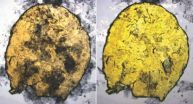This rapidly evolving research field is the focus of a new European Marine Board (EMB) position paper titled 'Land Beneath the Waves: Submerged Landscapes and Sea-Level Change.' The paper describes how during the successive ice ages of the last 1 million years, the sea level dropped at times by up to 120m, and the exposed area of the continental shelf added 40% to the land area of Europe; a terrain occupied by vegetation, fauna, and people. Consequently, many of the remains and artefacts of Europe's prehistory are now underwater. Considering that pre-humans inhabited the Black Sea coast 1.8 million years ago, the coast of northern Spain over 1 million years ago and; the coast of Britain at least 0.8 million years ago, the drowned land includes some of the earliest routes from Africa into Europe, and the areas where people survived during the multiple Ice Ages.
More than 2,500 submerged prehistoric artefact assemblages, ranging in age from 5,000 to 300,000 years, have been found in the coastal waters and open sea basins around Europe. Only a few have been properly mapped by divers, or assessed for preservation or excavation. These remains contain information on ancient seafaring, and the social structures and exploitation technologies of coastal resources before the introduction of agriculture some 10,000 years ago. To understand how prehistoric people responded to changing sea level, researchers combine examinations of these deposits with palaeoclimate models, reconstructions of ice-cap and sea level curves, and sophisticated survey and excavation techniques.
The EMB paper reports that seabed prehistoric remains are being destroyed by natural erosion and industrial disturbance. The paper stresses that Europe's submerged prehistory needs to be studied at a sea basin scale, and integrated at European level, which cannot be funded adequately by universities and national agencies alone. Compliance with the UNESCO convention on Underwater Cultural Heritage, and other treaties and directives, can only be ensured by collaboration and funding at European level.
The existing research community is sparse and scattered, and a new emphasis is needed for training marine archaeologists in Continental Shelf Prehistoric Research, while promoting collaboration with engineers, climate change experts and numerical modellers. Many initial findings are made by industrial operations, whose role can be strengthened by improving collaboration with national cultural heritage agencies and academics, both to encourage the reporting of findings and to map, protect, and where appropriate, excavate the archaeological materials such as hut foundations, hearths, food remains, skeletons, shaped flint tools, hand axes, and paddles for canoes embedded in the sediments on the sea floor.
The EMB Working Group, comprising experts from 11 European nations and chaired by Dr. Nicholas Flemming of the UK National Oceanography Centre, presented their recommendations after discussions over a 12 month period. The new position paper provides a comprehensive overview of recent progress in the study of our submerged cultural heritage and sets out key research questions and policy priorities needed to support this research in the future. It is an invaluable resource for policy makers, research funders and scientists alike. Professor Jan Mees, Chair of the European Marine Board, explains its importance: "our submerged cultural heritage is not a renewable resource; it is a unique irreplaceable cultural asset which can provide answers to many research questions about our prehistoric ancestors, landscapes and climate."
INFORMATION:
Notes to editors
European Marine Board supported the trans-disciplinary expert working group (EMB WG SUBLAND, Sept. 2013 to Oct. 2014).
This paper is officially launched on the evening of 7 October 2014 at the 15-year anniversary of the European Marine Board, a satellite event of the EurOCEAN Conference 2014 (7-9 October, Rome, Italy) and can be downloaded online at http://www.marineboard.eu/publications.
For more information please contact the European Marine Board Science Officer, Dr. Nan-Chin Chu, nchu@esf.org | Tel +32 (0) 59 34 01 54, +32 (0) 474 61 81 08
About the European Marine Board
The European Marine Board provides a pan-European platform for its member organizations to develop common priorities, to advance marine research and to bridge the gap between science and policy, in order to meet future marine science challenges and opportunities.
The European Marine Board (established in 1995) facilitates enhanced cooperation between European organizations involved in marine science (research performing institutes, research funding agencies and national networks of universities) towards development of a common vision on the research priorities and strategies for marine science in Europe. In 2014, the Marine Board represents 35 member organizations from 18 countries.
The European Marine Board works in association with the European Science Foundation (http://www.esf.org).
http://www.marineboard.eu
About The European Science Foundation
The European Science Foundation (ESF) was established in 1974 to provide a common platform for its Member Organisations – the main research funding and research performing organisations in Europe – to advance European research collaboration and explore new directions for research. ESF provides valuable services to the scientific and academic communities – such as peer review, evaluation, career tracking, conferences, implementation of new research support mechanisms and the hosting of high-level expert boards and committees – with the aim of supporting and driving the future of a globally competitive European Research Area. ESF currently has 66 member organisations in 29 countries. http://www.esf.org
Suggested reference:
Flemming, N.C., Çağatay, M.N., Chiocci, F.L., Galanidou, N., Jöns, H., Lericolais, G., Missiaen, T., Moore, F., Rosentau, A., Sakellariou, D., Skar, B., Stevenson, A., Weerts, H. (2014) Land Beneath the Waves: Submerged landscapes and sea level change. A joint geoscience-humanities strategy for European Continental Shelf Prehistoric Research. Chu, N.C. and McDonough, N. (Eds.) Position Paper 21 of the European Marine Board, Ostend, Belgium. 171 pp.
ISBN:978-94-920430-3-0.








